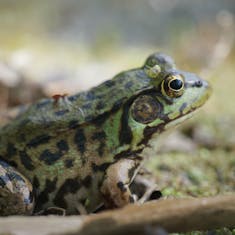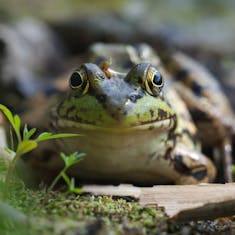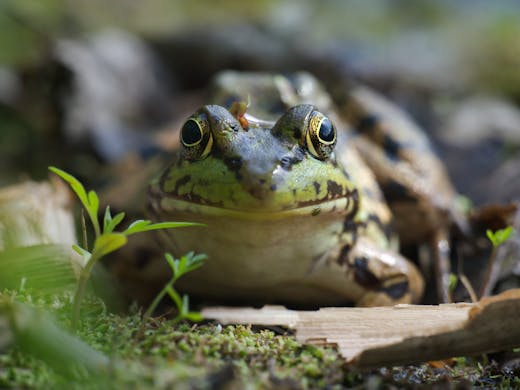Green Frog Lithobates clamitans
A mid-sized species of frog native to the eastern part of Canada. It lives near shallow ponds, lakes, rivers and swamps, mostly in the water.
Specs
| Length | 7-10cm |
| Weight | 25-50g |
Common Names
| German | Grüner Frosch |
| English | Green Frog |
| French | Grenouille verte |
| Spanish | Rana verde |
Taxonomy
| Order | Anura |
| Family | Ranidae |
| Species | Lithobates clamitans |
Advertisement
We need your help! By making a contribution towards our hosting costs, you can help us provide an ad-free experience on our website in the near future. Paypal
How to Identify
Green frogs closely resemble Bullfrogs. I identify green frogs by examining the crest, which begins behind their eyes and runs, in the case of green frogs, along the sides until it reaches the end of their back. Another distinctive characteristic is the size of the tympanum, which should be approximately the same size as their eye.




Green Frog Trivia
Is the Green Frog always green?
No, it is not always green. Its coloration can vary from light green to dark green, but it can also appear in shades of brown, bronze, or blue. Additionally, it may have brown spots and patches on its head and body.
Does the Green Frog have an eardrum larger than its eye?
No, it has an eardrum, tympanum, that is approximately the same size as its eye. The tympanum is a large, circular membrane located behind the eye, assisting the frog in hearing.
Does the Green Frog have skin folds on its back?
Yes, it possesses two prominent dorsolateral folds that extend partially down its back. These folds of skin serve to protect the frog from dehydration and predators.
Is the Green Frog a small frog?
No, it is a large frog that can reach lengths of about 10 cm, snout to vent, excluding the hind legs. Typically, females are larger than males. The green frog ranks among the largest frogs in eastern North America.
Does the Green Frog eat insects?
Yes, it feeds on insects and other small animals such as worms, spiders, snails, crayfish, and fish. It captures its prey using its long, sticky tongue to flick it into its mouth. Additionally, it can leap out of the water to catch flying insects or jump onto land to pursue terrestrial prey.
Does the Green Frog have predators?
Yes, it has predators, including raccoons, snakes, turtles, herons, hawks, and fish. To defend itself, it employs camouflage, jumps into water, or emits a distress call.
Does the Green Frog breed in summer?
Yes, it breeds from May to August in most of its range, but the timing may vary depending on the climate. Female frogs lay up to 5000 eggs in clusters attached to aquatic plants.
Does the Green Frog have external fertilization?
Yes, it undergoes external fertilization, meaning that the male releases sperm over the eggs as the female lays them. The fertilized eggs hatch into tadpoles after 3 to 7 days.
Does the Green Frog breed in temporary water bodies?
No, it breeds in permanent water bodies such as ponds, lakes, marshes, streams, and rivers. It requires water bodies that do not dry up before tadpoles complete their metamorphosis, which can take up to 22 months.
Does the Green Frog hibernate in winter?
Yes, it hibernates at the bottom of water bodies, in mud or leaf litter near the shore. It emerges from hibernation in the spring when the water temperature rises above 10°C.
Does the Green Frog have antifreeze compounds in its blood?
Yes, it possesses antifreeze compounds in its blood and tissues that aid in surviving freezing temperatures in winter. The green frog can tolerate up to 35% of its body water being frozen.
Does the Green Frog secrete a toxin from its skin?
Yes, it secretes a mild toxin from its skin that may deter some predators but is not harmful to humans or pets. The toxin is produced by glands in the skin and is released when the frog is stressed or injured.
Where and When to Spot
Can be seen from spring to autumn near water although difficult to spot outside of the mating season in spring when you can find them following their calls. I saw my first Green frog in Park Boisé des Douzes, St. Hyacinthe.
| Spring | Summer | Fall | Winter | |
|---|---|---|---|---|
| Jardin Botanique de Montréal | x | x | - | - |
| Parc Angrignon | x | x | - | - |
| Parc Bernard-Landry | x | - | - | - |
| Parc Michel-Chartrand | x | - | - | - |
| Parc de la Frayère | - | x | - | - |
Where and when a species has been observed, identified, and recorded.

